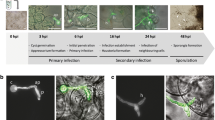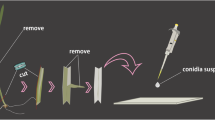Abstract
We used video microscopy techniques as a tool for live examination of the dynamic aspects of plant/fungus interactions. Early, dynamic responses of epidermal midrib cells of leaves from a potato cultivar (Solanum tuberosum L. cv. Datura) carrying resistance gene R1 to Phytophthora infestans (race 1: compatible interaction, race 4: incompatible interaction) were monitored. Similar responses were observed in both types of interaction, ranging from no visible reaction of invaded plant cells to hypersensitive cell death. The overall defense response of each individual cell exhibited a highly dynamic behavior that appeared to be tightly coordinated with the growth of the fungus. Initial localized reactions, including major rearrangements within the cytoplasm, occurred directly at the fungal penetration site, where rapid apposition of autofluorescent material and callose took place. If fungal invasion stopped at this stage, the host cell restored its normal cytoplasmic activity and survived. Hypersensitive cell death occurred only when fungal growth had proceeded to the formation of a clearly identifiable haustorium. In such cases, cytoplasm and nucleus conglomerated around the intracellular fungal structure, followed by a sudden collapse of the whole conglomerate and an instantaneous collapse of the fungal haustorium. Only small quantitative differences between the compatible and incompatible interactions of the two fungal races were observed for these early responses of epidermal cells. In the incompatible interaction, a slightly larger number of epidermal cells responded to fungal attack. More pronounced quantitative differences between compatible and incompatible interactions occurred upon fungal invasion of the mesophyll. These differences in the number of responding cells were not reflected at the level of gene expression: the spatial and temporal activation patterns of two defense-related genes, encoding phenylalanine ammonia-lyase and pathogenesis-related protein 1, were similar in both types of interaction.
Similar content being viewed by others
Abbreviations
- PAL:
-
phenylalanine ammonia-lyase
- PR1:
-
pathogenesis-related protein 1
- FITC:
-
fluorescein isothiocyanate
References
Aist, J.R., Israel, H.W. (1977) Papilla formation: timing and significance during penetration of barley coleoptiles by Erysiphe graminis hordei. Phytopathology 67, 455–461
Chen, C.Y., Heath, M.C. (1991) Cytological studies of the hypersensitive death of cowpea epidermal cells induced by basidiospore-derived infection by the cowpea rust fungus. Can. J. Bot. 69, 1199–1206
Coffey, M.D., Wilson, U.E. (1983) Histology and cytology of infection and disease caused by Phytophthora. In: Phytophthora, pp. 289–301, Erwin, D.C., Bartnicki-Garcia, S., Tsao, P.H., eds. Am. Phytopath. Soc., St. Paul
Cuypers, B., Hahlbrock, K. (1988) Immunohistochemical studies of compatible and incompatible interactions of potato leaves with Phytophthora infestans and of the nonhost response to Phytophthora megasperma. Can. J. Bot. 66, 700–705
Cuypers, B., Schmelzer, E., Hahlbrock, K. (1988) In situ localization of rapidly accumulated phenylalanine ammonia-lyase mRNA around penetration sites of Phytophthora infestans in potato leaves. Mol. Plant-Microbe Interact. 1, 157–160
Doke, N. (1982) A further study on the role of hypersensitivity in resistance of potato cultivars to infection by an incompatible race of Phytophthora infestans. Physiol. Plant Pathol. 21, 85–95
Ferris, V. (1955) Histological study of pathogen-suscept relationships between Phytophthora infestans and derivatives of Solanum demissum. Phytopathology 45, 546–552
Flor, H.H., (1971) Current status of the gene-for-gene concept. Annu. Rev. Phytopathol. 9, 275–298
Gees, R., Hohl, H.R. (1988) Cytological comparison of specific (R3) and general resistance to late blight in potato leaf tissue. Phytopathology 78, 350–357
Groß, P., Julius, C., Schmelzer, E., Hahlbrock, K. (1993) Translocation of cytoplasm and nucleus to fungal penetration sites is associated with depolymerisation of microtubules and defense gene activation in infected, cultured parsley cells. EMBO J. 12, 1735–1744
Hächler, H., Hohl, H.R. (1984) Temporal and spatial distribution patterns of collar and papillae wall appositions in resistant and susceptible tuber tissue of Solanum tuberosum infected by Phytophthora infestans. Physiol. Plant Pathology 24, 107–118
Hahlbrock, K., Arabatzis, N., Becker-André, M., Joos, H.-J., Kombrink, E., Schröder, M., Strittmatter, G., Taylor, J. (1989) Local and systemic gene activation in fungus-infected potato leaves. In: Signal molecules and plant-microbe interactions (NATO ASI Series, vol. H 36) pp. 242–249, mLugtenberg, B.J.J., ed. Springer, Berlin
Hazen, B.E., Bushnell, W.R. (1983) Inhibition of the hypersensitive reaction in barley to powdery mildew by heat shock and cytochalasin B. Physiol. Plant Pathol. 23, 421–438
Hohl, H.R., Suter, E. (1976) Host-parasite interfaces in a resistant and a susceptible cultivar of Solanum tuberosum inoculated with Phytophthora infestans: leaf tissue. Can. J. Bot. 54, 1956–1970
Joos, H-J., Hahlbrock, K. (1992) Phenylalanine ammonia-lyase in potato (Solanum tuberosum L.): Genomic complexity, structural comparison of two selected genes, and modes of expression. Eur. J. Biochem. 204, 621–629
Kitazawa, K., Tomiyama, K. (1969) Microscopic observations of infection of potato cells by compatible and incompatible races of Phytophthora infestans.Phytopath. Z. 66, 317–324
Kitazawa, K., Inagaki, H., Tomiyama, K. (1973) Cinephotomicro-graphic observations on the dynamic responses of protoplasm of a potato cell to infection by Phytophthora infestans. Phytopath. Z. 76, 80–86
Knogge, W. (1991) Plant resistance genes for fungal pathogensphysiological models and identification in cereal crops. Z. Naturforsch. 46c, 969–981
Kombrink, E., Beerhus, L., Garcia-Garcia, F., Hahlbrock, K., Müller, M., Schröder, M., Witte, B., Schmelzer, E. (1993) Expression patterns of defense-related genes in infected and uninected plants. In: Mechanisms of plant defense responses (Proceedings of the 2nd conference of the european foundation for plant pathology), pp. 236–249, Fritig, B., Legrand, M., eds. Kluwer Academic Publ., Dordrecht
Meyer, S.L.F., Heath, M.C. (1988) A comparison of the death induced by fungal invasion or toxic chemicals in cowpea epidermal cells. I. Cell death induced by heavy metal salts. Can. J. Bot. 66, 613–623
McFadden, G.I., Bonig, I., Cornish, E.C., Clarke, A.E. (1988) A simple fixation and embedding method for use in hybridization histochemistry on plant tissues. Histochemical J. 20, 575–586
Pristou, R., Gallegly, M.E. (1954) Leaf penetration by Phytophthora infestans. Phytopathology 44, 81–86
Schmelzer, E., Krüger-Lebus, S., Hahlbrock, K. (1989) Temporal and spatial patterns of gene expression around sites of attempted fungal infection in parsley leaves. Plant Cell 1, 993–1001
Schröder, M., Hahlbrock, K., Kombrink, E. (1992) Temporal and spatial patterns of 1,3-β-glucanase and chitinase induction in potato leaves infected by Phytophthora infestans. Plant J. 2, 161–172
Shimony, C., Friend, J. (1975) Ultrastructure of the interaction between Phytophthora infestans and leaves of two cultivars of potato (Solanum tuberosum L.) Orion and Majestic. New Phytol. 74, 59–64
Spielman, L.J., McMaster, B.J., Fry, W.E. (1989) Dominance and recessiveness for virulence against potato and tomato in Phytophthora infestans. Theor, Appl. Genet. 77, 832–838
Taylor, J.L., Fritzemeier, K.H., Häuser, I., Kombrink, E., Rohwer, F., Schröder, M., Strittmatter, G., Hahlbrock, K. (1990) Structural analysis and activation by fungal infection of a gene encoding a pathogenesis-related protein in potato. Mol. PlantMicrobe Interact. 3, 72–77
Tomiyama, K. (1956) Cell physiological studies on the resistance of potato plant to Phytophthora infestans. Ann. Phytopath. Soc. Jap. 21, 54–62
Tomiyama, K. (1971) Cytobiological and biochemical studies of the hypersensitive reaction of potato cells to Phytophthora infestans. In: Morphological events in plant-parasite interactions, pp. 387–399, Akai, S., Quchi, S., eds Phytopath. Soc. of Japan, Tokyo
Tomiyama, K. (1983) Research on the hypersensitive response. Annu. Rev. Phytopathol. 21, 1–12
Tourtelotte, W.W., Verity, A.N., Schmid, P., Martinez, S., Shapshak, P. (1987) Covalent binding of formalin fixed paraffin embedded brain tissue sections to glass slides suitable for in situ hybridization. J. Virol. Meth. 15, 87–99
Wilson, U.E., Coffey, M.D. (1980) Cytological evaluation of general resistance to Phytophthora infestans in potato foliage. Ann. Bot. 45, 81–90
Woods, A.M., Fagg, J., Mansfield, J.W. (1988) Fungal development and irreversible membrane damage in cells of Lactuca sativa undergoing the hypersensitive reaction to the downy mildew fungus Bremia lactucae. Physiol. Mol Plant Pathol. 32, 483–497
Xu, H., Mendgen, K. (1991) Early events in living epidermal cells of cowpea and broad bean during infection with basidiospores of the cowpea rust fungus. Can. J. bot. 69, 2279–2285
Author information
Authors and Affiliations
Additional information
Dedicated to Professor Peter Sitte, Freiburg, Germany, on the occasion of his 65th birthday
It is a great pleasure to thank W. Sacks, W. Knogge and D. Scheel, Max-Planck-Institut für Züchtungsforschung, Köln, Germany, for critically reading the manuscript. This work was supported in part by Bundesministerium für Forschung und Technologie and Fonds der chemischen Industrie.
Rights and permissions
About this article
Cite this article
Freytag, S., Arabatzis, N., Hahlbrock, K. et al. Reversible cytoplasmic rearrangements precede wall apposition, hypersensitive cell death and defense-related gene activation in potato/Phytophthora infestans interactions. Planta 194, 123–135 (1994). https://doi.org/10.1007/BF00201043
Received:
Accepted:
Issue Date:
DOI: https://doi.org/10.1007/BF00201043




